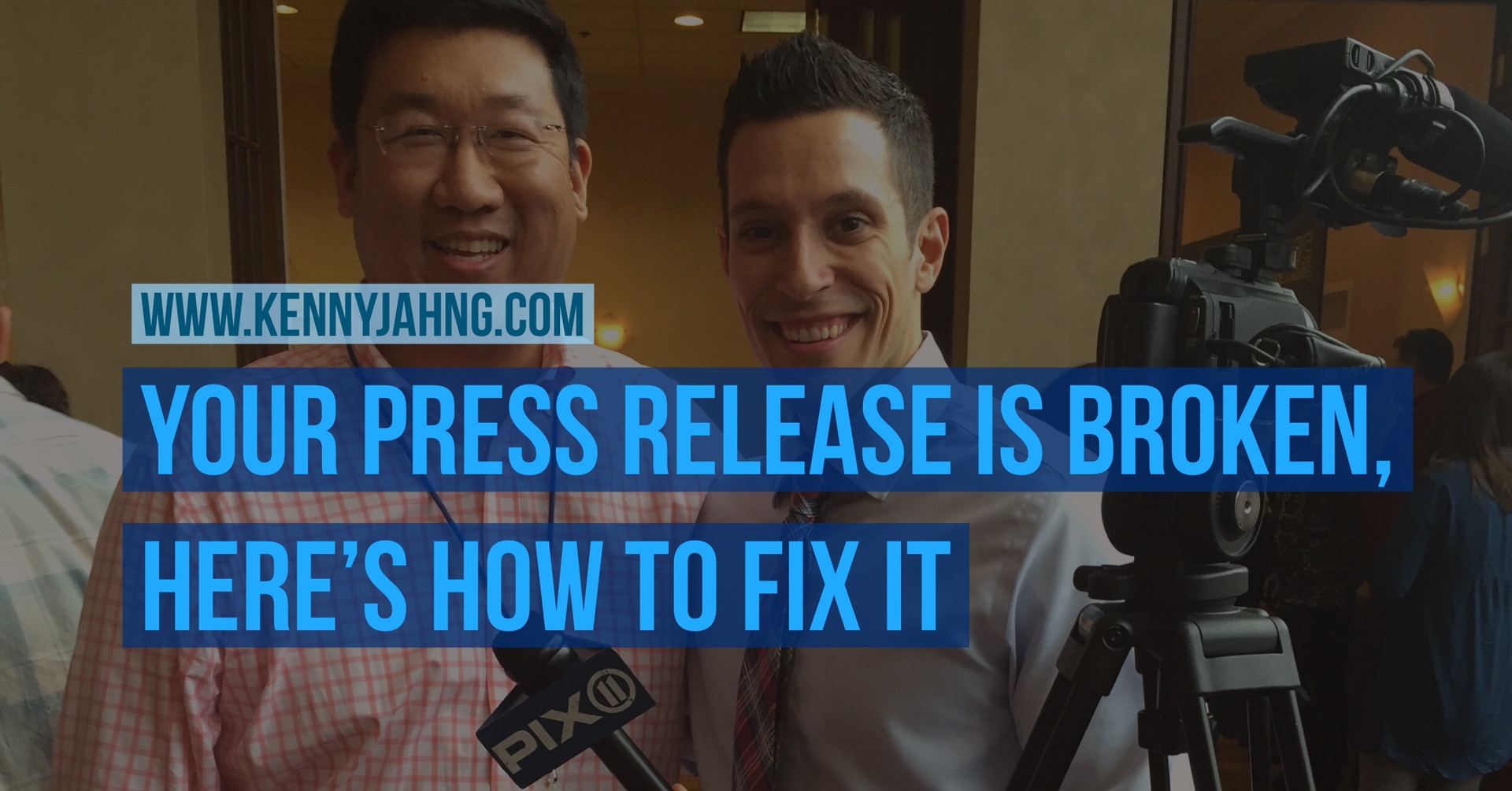Press releases can be a very powerful tool in any communications toolbox. But can nonprofits and churches use them successfully in today’s world?
THE RED HERRING
I’ve had many people comment to me personally, that the media’s default position against the Church and anything Jesus related makes it impossible for them to get any meaningful traction with the press these days.
But in my experience, that really is not the case. During my tenure leading media relations for Liquid Church our team was able to garner earned media coverage in the local, state, national, and international news on a consistent basis. For my agency’s clients, we have used press releases successfully. One press release brought in $30,000 in donations within weeks without any interaction, no phone calls, no email campaigns, etc. I am talking checks in the mail. #PRworks.
Stop blaming the wrong thing. The press isn’t against you. You just aren’t telling dynamic stories in the way they should be told today.
I want to help explain some of the biggest reasons you aren’t getting traction with press releases. And how you can change them to get some exposure and attention for your campaign.
THE FIRST TWO UNDERLYING REASONS
There are two key reasons why many church and faith-based organization communicators are having trouble getting their story out in today’s media world:
THE MISSING INGREDIENT
First, most churches are telling the public really poorly crafted stories.
News in the media is a lot like happy hour or cocktail party chatter. Any tidbit of info you share needs to stand on its own merits before it can be passed from one circle to another and beyond.
If you engaged with someone in a social setting in a way that you only talk about yourself over and over again, and always expected others to pay attention to the mundane details of your live without any potential relevance or context for where of the story was being shared, no one would ever return back to you from their visit to the punch bowl. Right?
“Engage culture” is such a trendy phrase to thrown around by church leaders these days. But if you read even just the first half a dozen press releases coming out from church and faith based organizations today, you would really start to wonder if they understood what that phrase actually means.
The #1 must-do rule is that you must position and craft your story in a way that is relevant to your audience. Anyone who reads it should be able to answer “what’s in it for me?” We call this the WIIFM. (Say “whiff-em”)
The “WIIFM” What’s In It For Me is the most common missing ingredient in press releases I read.
No one in your community really cares if you are putting on a pancake breakfast for the men’s ministry. I understand that it is “open to the public” and that you would welcome any person who decided to show up on your doorstep for that meeting. I understand that you would greet them with open arms and feed them unlimited pancakes as if it was an IHOP buffet.
But still that story will not fly if you have not clearly demonstrated the WIIFM. Not if you haven’t made it numbingly clear that this isn’t a member event, it is a community event. The story won’t fly if you haven’t structured the events in a way that there is no easy on-ramp for strangers.
Don’t call them guests. Don’t call them visitors. They are strangers.
Just re-read that last paragraph and think about it for a second.
How is a plain stranger who has never walked into or even by your building going to be comfortable enough to read your news and think that they actually should consider putting it on their calendar? You need to answer that question in your event planning and storytelling.
THREE BARRIERS YOUR STORY NEEDS TO OVERCOME
Your stories also need to transcend the ABC paradigm of church which the culture knows all too well. What is the ABC church you ask? It’s the fact that churches only care about 3 things:
A for attendance. It’s all about them coming to your church. Not us to them. They must “join us.” Not us going out and meeting them.
B for your building. It’s all about and on your turf. Outsiders must come to and inside the building associated with tons of baggage in the average non-church goer’s mind because their past experiences with “church.” And the church always want a bigger better building. Always.
And C for cashola. The church wants all your money. Hide your wallets, because the church expects you to pay big time. Maybe not today at the “free” event, but “they’ll get you somehow.”
There are plenty of other aspects of architecting a story for press releases that hit on relevance and context, but figuring out how to address those issues should give you a big jump on helping you to re-examine your “news” so you can start to “engage culture” and your community in a better way.
THE RULES HAVE CHANGED
The second reason is a BIG one. And if you haven’t been paying attention, things have changed.
So if you look up any textbook on public relations and writing press releases, you’ll find tons of advice that say your press releases need to be pithy.
400 words or less used to be the common sense target for anyone assigned a to write press release.
Just the facts. Do not add anything else beside the bare minimum.
In fact, to this day, I have been counseled by PR agency staff hired by clients giving feedback on a press release I have written for them, that you should include all the most important information upfront first. And upside down triangle is the visual model you may have seen.
Journalism–trained writers have told me repeatedly, you need to write for the assigned journalist or news desk. They do not have time to read your 800 word press release.
The general rule on the street is that you need to get through the 5 W’s all within the first couple of sentences of your first paragraph. No lead in, just the facts, please.
BUT THIS IS NOT TRUE AT ALL ANYMORE
I can already feel the blood pressure rising in any traditionally trained public relations professional reading this.
There are many many factors contributing to why I believe that the rules have changed on this one today.
The topic itself needs a deep dive for which I will further discuss in the future as we go along. But for now, I’ll touch upon just a couple of things that stand out to help you see what I have been seeing.
The number one factor that has changed the way I have been writing press releases these days is that the nature of the business of journalism has changed.
Cable news started it all. Internet news outlets have firmly solidified this shift in paradigm: The news business, and I emphasize the word “business,” is now a 24/7 game.
They are no longer just reporters of news, but rather content producers who must attract their share of eyeballs.
Some have adjusted better than others, but the fact remains, there is relentless pressure today to search and find interesting, unique, relevant stories to put in front of their audience every day, every hour.
Just ask any reporter about this. You will undoubtedly be on the receiving end of the outpouring of commiseration for how the job has changed.
Reporters do not have the resources, and more importantly — time, to do full-blown follow up and investigation/verification these days. And I am not just talking about small local outlets. I’m talking national brand news.
Reporters are on deadlines that are not realistic, and you have the ability to be their hero.
This is a BIG opportunity for you if you are trying to get published.
Please remember, I have been successful in using this specific approach in getting coverage of what is essentially a “local church story” repeatedly on major outlets like ABC, CNN, FOX, the NJ state paper, The Star-Ledger and NJ.com, and more. And it hasn’t been a one hit wonder experience.
I firmly believe to my core you must abandon the old rules if you want to be successful in leveraging news and media outlets today.
HOW I WRITE MY PRESS RELEASES TODAY
Here is my core press release writing formula: Write your release exactly as you would see the story written in verbatim on the front page of the New York Times, the Washington Post, read by the anchor on CNN, etc.
Today, your press releases are no longer being written to the journalist. You are writing for the audience.
Another way to think of it is, how can you make the journalist’s job as easy as possible if they were assigned your story?
If you were subbing in for the journalist in their job, you would write a compelling article that has an opening lead the triggers curiosity, wonder, or natural interest. You would potential create an open loop at the beginning of the article, which means not all of the facts or stuffed into the first two or three sentences of the press release. You would write the entire article. Not biased. Not self-centered. That’s what you need to do.
BEST CASE SCENARIO
Your ideal scenario as the publisher of a press release is that a journalist will pick up your release and copy it verbatim and submit it to the editor for publishing.
This is a phenomenon that has happened in almost every case we have gotten press using press releases over the last 7 years. It happens so often that it really is shocking.
That means you really need to understand the style of the media outlets you are targeting. It also means that you might have more than one version of your press release that you send out. One size does not fit all anymore. It’s like resume writing today. You need to tailor your piece for the recipient if you want to cut brought the clutter and make it out alive.
You want your copy to fit like a glove for any given outlet that receives it.
You need to make it as easy as possible for them to take it and run with it.
It means potentially sourcing quotes from someone outside of your organization or church and including that in the press release.
It also means providing an FAQ document with real questions that a journalist might ask.
Want to increase your chances of getting published by 5X or more? Make sure to include some photography that supports the story which are not stock, or amateur. Hiring a local photographer or getting a super hobbyist photographer in your church to help out with this assignment is going to do wonders for getting published. If you could share complementary photography that matches the style of the media outlet for what they use across their paper, website, or video program, you will be turbo boosted to the finalist round immediately.
Today, all media has gone from text to visuals. You need to pay attention to that if you are trying to help them tell stories to their audience.
THE SECRET SAUCE?
THIS, is how I have gotten press over and over again over the last several years. There really is no magic formula. No secret sauce. No hidden network.
But rather, a huge seismic shift in who you are writing for, how you are writing the story and what you offer with it.




Interesting stuff Kenny!
Can you give us some examples you have used?
Thanks!